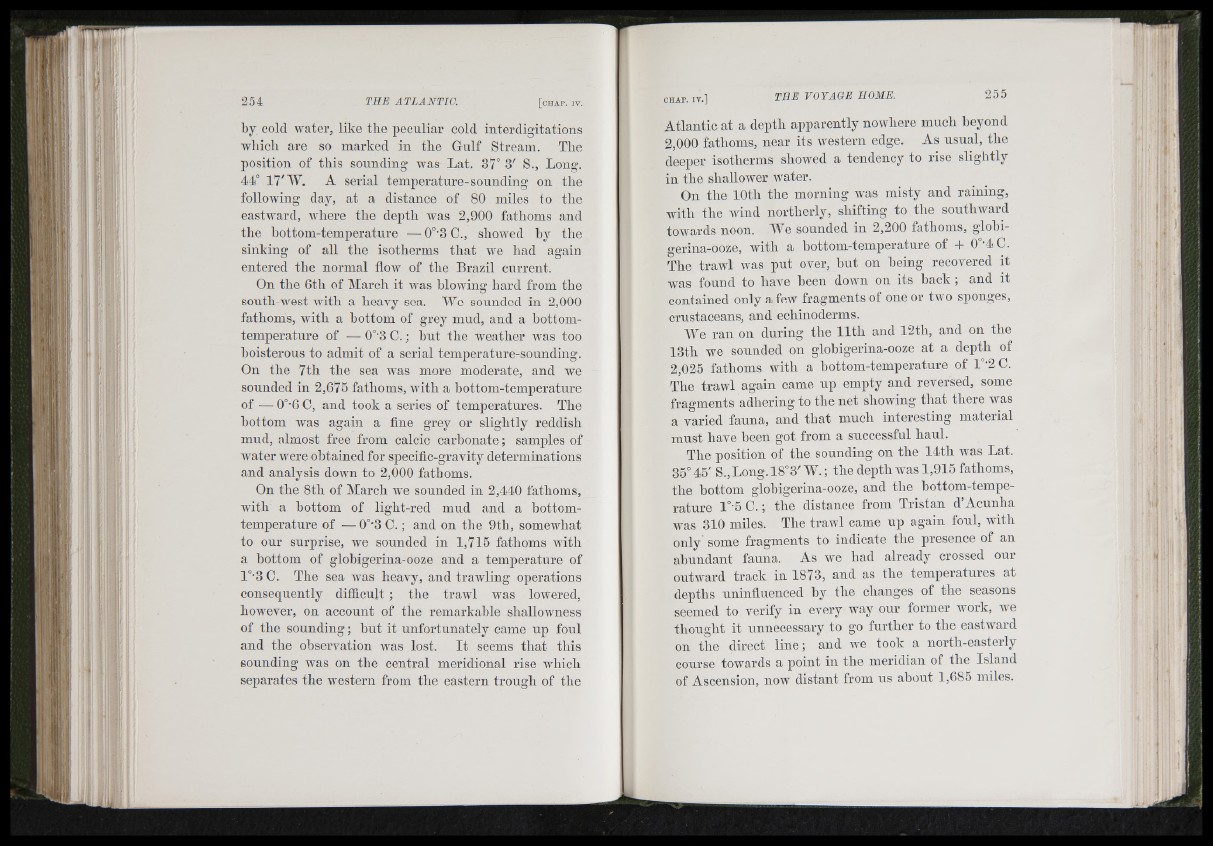
q[i 'I
Mg
g;;,
"I
i ’!'
‘'III
by cold water, like tbe peculiar cold interdigitations
wbicb are so marked in the Gulf Stream. The
position of this sounding was Lat. 37° 3' S., Long.
44° l7'AAk A serial temperature-sounding on the
following day, at a distance of 80 miles to the
eastward, where the depth was 2,900 fathoms and
the hottom-temperature — 0°'3 0., shoAved by the
sinking of all the isotherms that AA'e had again
entered tbe normal Aoaa' of the Brazil current.
On the 6th of March it Avas hloAA'ino’O hard from the
south-AA'est AA'ith a heavy sea. AVe sounded in 2,000
fathoms, with a hottom of grey mnd, and a hottom-
temperature of — 0°-3 C. ; hut the weather Avas too
boisterous to admit of a serial temperature-sounding.
On the 7th the sea Avas more moderate, and we
sounded in 2,675 fathoms, Avitli a hottom-temperature
of — 0°-6 C, and took a series of temperatures. The
hottom was again a fine grey or slightly reddish
mnd, nlmost free from calcic carbonate; samples of
Avater Avere ohtained for specilic-gravity determinations
and analysis doAA'n to 2,000 fathoms.
On the 8th of March we sounded in 2,440 fathoms,
with a hottom of light-red mud and a hottom-
temperature of — 0°-3C. ; and on the 9th, somewhat
to our surprise, we sounded in 1,715 fathoms with
a bottom of globigerina-ooze and a temperature of
l°-3 C. The sea Avas heavy, and trawling operations
consequently difficult ; the trawl was lowered,
hoAvever, on account of the remarkable shalloAvness
of the sounding ; hut it unfortunately came up foul
and the observation was lost. I t seems th a t this
sounding was on the central meridional rise Avhich
separates the western from the eastern trough of the
Atlantic at a depth apparently noAvhere much beyond
2,000 fathoms, near its Avestern edge. As usual, the
deeper isotherms showed a tendency to rise slightly
in the shallower water.
On th e lOtli th e m o rn in g w as m is ty a n d r a in in g ,
w ith th e AA'ind n o r th e r ly , s h if tin g to th e s o u thw a rd
toAvards noon. so u n d e d in 2,200 fa th om s , g lo b igerin
a -o o z e , w ith a h o ttom - tem p e r a tu r e o f -8 0°'4C.
T h e tr aw l Avas p u t over, b u t o n h e in g re co v e re d i t
w a s fo n n d to h a v e h e e n d ow n o n it s b a c k ; a n d i t
c o n ta in e d o n ly a few f r a gm e n ts o f on e o r tw o sp o n g e s,
c ru s ta c e a n s , a n d e c h in o d e rm s .
AVe ran on during the 11th and 12th, and on the
13th we sounded on glohigerina-ooze at a depth of
2,025 fathoms with a hottom-temperature of 1°'2 C.
The trawl again came up empty and reversed, some
fragments adhering to the net shoAving that there Avas
a varied fanna, and that much interesting material
must have been got from a successful hanl.
The position of the sounding on the 14th was Lat.
35° 45' S.,Long. 18°3' AA". ; the depth AA'as 1,915 fathoms,
the hottom globigerina-ooze, and the hottom-temperature
r-5 C. ; the distance from Tristan d’Acunha
Avas 310 miles. The traAvl came up again foul, with
only some fragments to indicate the presence of an
ahundant fanna. As Ave had already crossed our
outward track in 1873, and as the tempei’atnres at
depths nninflnenced hy the changes of the seasons
seemed to verify in every way our former AVork, Ave
thought it unnecessary to go further to the eastward
on the direct line; and Ave took a north-easterly
course towards a point in the meridian of the Island
of Ascension, now distant from us ahont 1,685 miles.